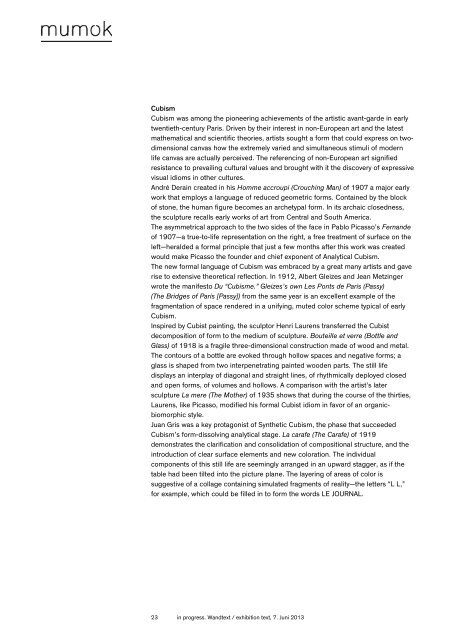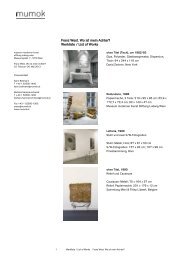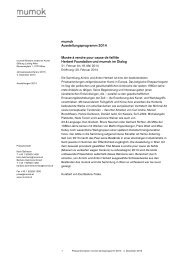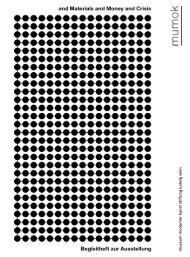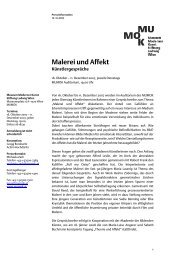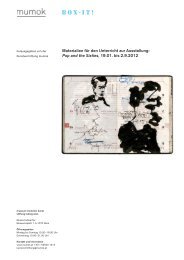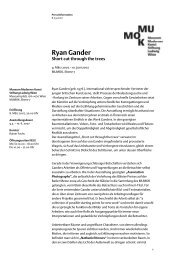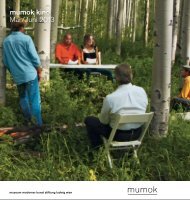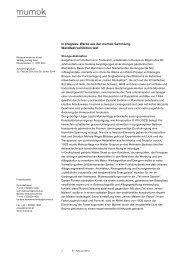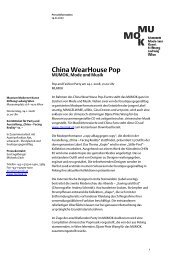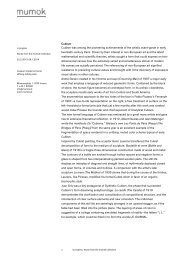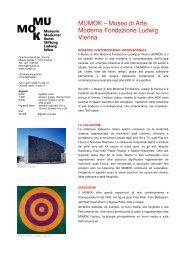in progress. Werke aus der mumok Sammlung Wandtext/exhibition text
in progress. Werke aus der mumok Sammlung Wandtext/exhibition text
in progress. Werke aus der mumok Sammlung Wandtext/exhibition text
Erfolgreiche ePaper selbst erstellen
Machen Sie aus Ihren PDF Publikationen ein blätterbares Flipbook mit unserer einzigartigen Google optimierten e-Paper Software.
Cubism<br />
Cubism was among the pioneer<strong>in</strong>g achievements of the artistic avant-garde <strong>in</strong> early<br />
twentieth-century Paris. Driven by their <strong>in</strong>terest <strong>in</strong> non-European art and the latest<br />
mathematical and scientific theories, artists sought a form that could express on twodimensional<br />
canvas how the extremely varied and simultaneous stimuli of mo<strong>der</strong>n<br />
life canvas are actually perceived. The referenc<strong>in</strong>g of non-European art signified<br />
resistance to prevail<strong>in</strong>g cultural values and brought with it the discovery of expressive<br />
visual idioms <strong>in</strong> other cultures.<br />
André Dera<strong>in</strong> created <strong>in</strong> his Homme accroupi (Crouch<strong>in</strong>g Man) of 1907 a major early<br />
work that employs a language of reduced geometric forms. Conta<strong>in</strong>ed by the block<br />
of stone, the human figure becomes an archetypal form. In its archaic closedness,<br />
the sculpture recalls early works of art from Central and South America.<br />
The asymmetrical approach to the two sides of the face <strong>in</strong> Pablo Picasso’s Fernande<br />
of 1907—a true-to-life representation on the right, a free treatment of surface on the<br />
left—heralded a formal pr<strong>in</strong>ciple that just a few months after this work was created<br />
would make Picasso the foun<strong>der</strong> and chief exponent of Analytical Cubism.<br />
The new formal language of Cubism was embraced by a great many artists and gave<br />
rise to extensive theoretical reflection. In 1912, Albert Gleizes and Jean Metz<strong>in</strong>ger<br />
wrote the manifesto Du “Cubisme.” Gleizes’s own Les Ponts de Paris (Passy)<br />
(The Bridges of Paris [Passy]) from the same year is an excellent example of the<br />
fragmentation of space ren<strong>der</strong>ed <strong>in</strong> a unify<strong>in</strong>g, muted color scheme typical of early<br />
Cubism.<br />
Inspired by Cubist pa<strong>in</strong>t<strong>in</strong>g, the sculptor Henri Laurens transferred the Cubist<br />
decomposition of form to the medium of sculpture. Bouteille et verre (Bottle and<br />
Glass) of 1918 is a fragile three-dimensional construction made of wood and metal.<br />
The contours of a bottle are evoked through hollow spaces and negative forms; a<br />
glass is shaped from two <strong>in</strong>terpenetrat<strong>in</strong>g pa<strong>in</strong>ted wooden parts. The still life<br />
displays an <strong>in</strong>terplay of diagonal and straight l<strong>in</strong>es, of rhythmically deployed closed<br />
and open forms, of volumes and hollows. A comparison with the artist’s later<br />
sculpture La mere (The Mother) of 1935 shows that dur<strong>in</strong>g the course of the thirties,<br />
Laurens, like Picasso, modified his formal Cubist idiom <strong>in</strong> favor of an organicbiomorphic<br />
style.<br />
Juan Gris was a key protagonist of Synthetic Cubism, the phase that succeeded<br />
Cubism’s form-dissolv<strong>in</strong>g analytical stage. La carafe (The Carafe) of 1919<br />
demonstrates the clarification and consolidation of compositional structure, and the<br />
<strong>in</strong>troduction of clear surface elements and new coloration. The <strong>in</strong>dividual<br />
components of this still life are seem<strong>in</strong>gly arranged <strong>in</strong> an upward stagger, as if the<br />
table had been tilted <strong>in</strong>to the picture plane. The layer<strong>in</strong>g of areas of color is<br />
suggestive of a collage conta<strong>in</strong><strong>in</strong>g simulated fragments of reality—the letters “L L,”<br />
for example, which could be filled <strong>in</strong> to form the words LE JOURNAL.<br />
23 <strong>in</strong> <strong>progress</strong>. <strong>Wand<strong>text</strong></strong> / <strong>exhibition</strong> <strong>text</strong>, 7. Juni 2013


